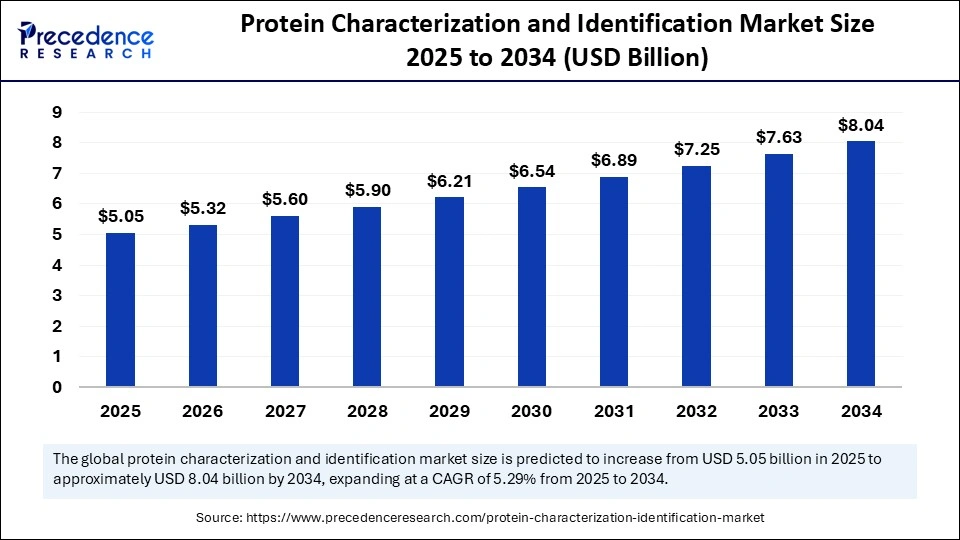The global protein characterization and identification market, valued at USD 4.80 billion in 2024, is forecast to expand to approximately USD 8.04 billion by 2034, growing at a compound annual growth rate (CAGR) of 5.29% from 2025 to 2034. This impressive growth trajectory is propelled by escalating demand for advanced analytical technologies in drug development, biotechnology research, and stringent quality control processes within pharmaceuticals and life sciences.

The market landscape is shaped by the increasing need for detailed structural and functional analysis of complex biological molecules such as therapeutic proteins, biologics, and monoclonal antibodies. Rapid advancements in characterization methods spanning mass spectrometry, chromatography, electrophoresis, and spectroscopy are enabling researchers to meet regulatory demands and accelerate drug discovery pipelines with greater precision. The growing biopharmaceutical industry, combined with heightened R&D investments and the emergence of personalized medicine, forms the bedrock of this sector’s robust expansion.
Protein Characterization and Identification Market Key Insights
-
The market value stood at USD 4.80 billion in 2024 and is expected to reach USD 5.05 billion in 2025.
-
North America dominates with USD 1.44 billion in 2024 and is projected to grow significantly by 2034, led by biopharmaceutical strength and R&D infrastructure.
-
Asia Pacific emerges as the fastest-growing region, driven by expanding biotech sectors and government support in life sciences research.
-
The market segments include instruments, consumables, reagents, software, and services, integrated into workflows involving protein sequencing, PTM analysis, and interaction studies.
-
Leading technologies such as mass spectrometry (LC-MS/MS, MALDI-TOF) uphold dominance due to their sensitivity and versatility.
Get this report to explore global market size, share, CAGR, and trends, featuring detailed segmental analysis and an insightful competitive landscape overview @ https://www.precedenceresearch.com/sample/6728
Protein Characterization and Identification Market Revenue Breakdown (USD Billion):
| Year | Market Size |
|---|---|
| 2024 | 4.80 |
| 2025 | 5.05 |
| 2034 (Forecast) | 8.04 |
Artificial intelligence (AI) is revolutionizing protein characterization by automating complex data analysis and enhancing predictive accuracy. Leveraging machine learning algorithms, AI rapidly processes large proteomic datasets, detects subtle patterns, and predicts protein structures and interactions more accurately than traditional methods.
This minimizes experimental errors and variability, while also speeding up workflows through high-throughput automation. AI-driven tools are thus pivotal in increasing the dependability, efficiency, and reproducibility of protein analysis essential for drug development and personalized medicine applications.
Protein Characterization and Identification Market Growth Drivers
The market’s growth is driven by multiple factors:
-
Increasing biopharmaceutical production necessitates accurate protein characterization for therapeutic safety and efficacy.
-
High-throughput screening platforms enable rapid analysis of thousands of proteins, accelerating diagnostics and drug discovery.
-
Expansion of biologics, biosimilars, and personalized medicine fuels demand for sophisticated characterization tools.
-
Strategic investments in proteomics infrastructure and government funding enhance regional growth, especially in Asia Pacific.
What Emerging Opportunities and Trends Are Shaping This Market?
How is the rise of biologics and biosimilars impacting market demand?
The surge in therapeutic proteins and biosimilars development requires stringent analytical validation to ensure safety and regulatory compliance, thereby increasing reliance on advanced protein characterization platforms.
What role does personalized medicine play in this market’s future?
Personalized medicine’s emphasis on biomarker discovery and disease-specific protein profiling drives demand for high-resolution protein analysis technologies, fostering innovation in proteomics workflows.
How are technological advancements repositioning service providers and end users?
Outsourcing specialized characterization to CROs and proteomics service providers is growing rapidly, especially in emerging economies, as they offer scalability, regulatory expertise, and cost efficiency.
Protein Characterization and Identification Market Regional and Segmentation Analysis
North America retains market leadership due to a mature biopharma ecosystem, stringent regulatory standards, and robust R&D investments. Asia Pacific, as the fastest-growing region, benefits from increasing clinical trials activity, domestic biotech emergence, and government support. Europe holds strong with established pharma clusters. Latin America and Middle East & Africa represent emerging markets with growing research infrastructure.
Segmentation Analysis
-
Instruments and systems dominate the product offering segment, underpinning high-resolution and real-time protein analysis.
-
Consumables and reagents show fastest growth due to recurring demand in protein workflows.
-
Mass spectrometry remains the leading technology due to its unmatched sensitivity and diverse applications.
-
Biophysical and interaction analysis technologies are fast-growing, crucial for understanding protein-ligand dynamics in drug discovery.
-
Protein identification and sequencing lead workflow stages, fundamental to proteomic research.
-
Recombinant/biotherapeutic proteins dominate sample types due to their therapeutic importance.
-
Biopharmaceutical companies and CROs lead end user segments, driving tool and service demand.
Latest Breakthroughs and Industry Players
Top companies driving innovation include Agilent Technologies, Bruker Corporation, Danaher Corporation, Thermo Fisher Scientific, PerkinElmer, Bio-Rad Laboratories, and Waters Corporation. These industry leaders continue to develop advanced mass spectrometry platforms, biophysical characterization tools, and AI-integrated software solutions that are transforming protein research and drug development landscapes.
Challenges and Cost Pressures
Despite growth opportunities, high costs associated with advanced instrumentation (such as NMR systems and high-resolution mass spectrometers) and operational expenses limit wider adoption, particularly among smaller labs and educational institutions. Additionally, the complexity of protein characterization demands highly skilled personnel, and the shortage of trained staff remains a significant hurdle for market expansion.
Case Study
A leading biopharmaceutical firm recently expedited its biologics development by integrating an AI-enhanced LC-MS/MS system for protein characterization, reducing turnaround times by 30% and significantly improving the accuracy of post-translational modification detection. This implementation not only accelerated regulatory submissions but also optimized the manufacturing quality control processes, underscoring the market impact of technological advancements.
Read Also: Pharmaceutical Blister Packaging Market
You can place an order or ask any questions. Please feel free to contact us at sales@precedenceresearch.com |+1 804 441 9344
- Powder Bonding 3D Printing Construction Market Build complex formwork with precision, customization, and sustainable design - September 9, 2025
- Protein Characterization and Identification Market Set to Reach USD 8.04 Billion by 2034 Fueled by 5.29% CAGR and AI-Driven Innovations - September 9, 2025
- Automotive Simulation Software Market Size to Cross USD 24.35 Billion by 2034 - September 8, 2025
